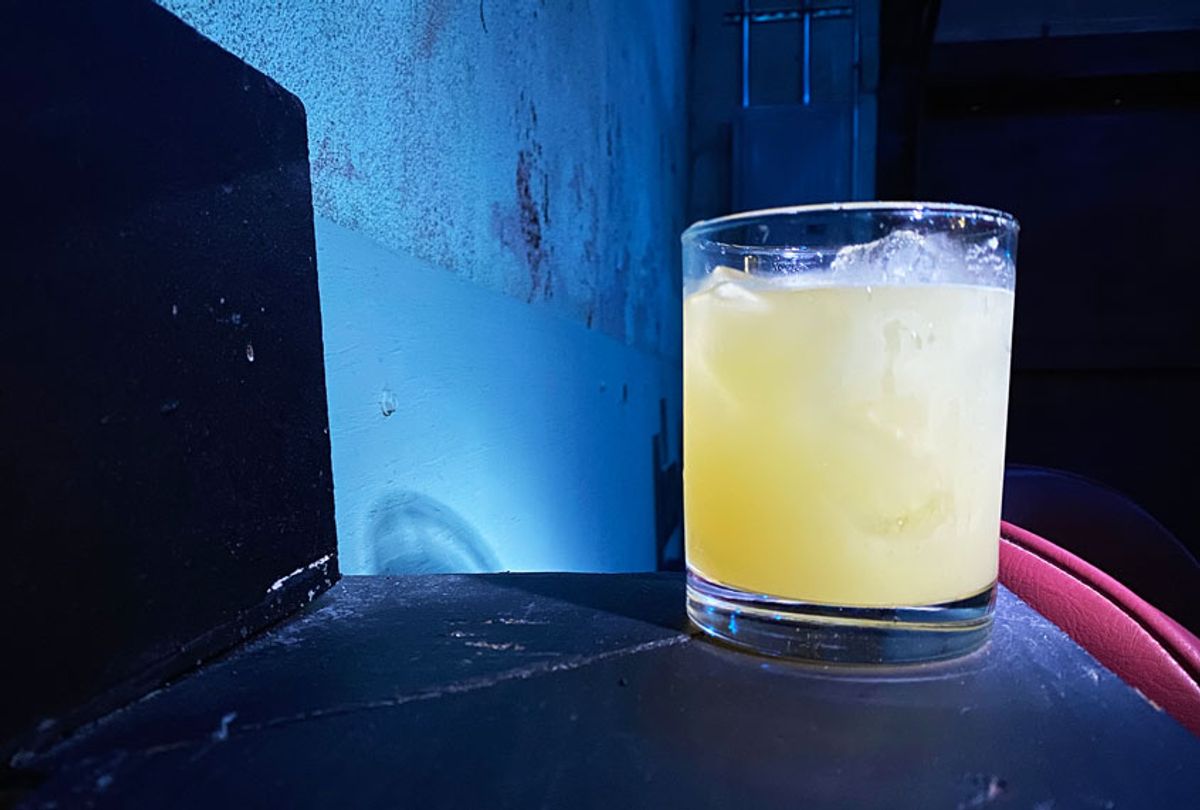There's a plastic deli tub of "Super Juice" behind the bar at Expo, a sort of nouveau-dive situated just outside the halo of lights that illuminates Louisville's historic Whiskey Row. Made with lemon and lime peels, the mixture is a potent, pucker-inducing blast — almost like a supercharged Lemon Lime Gatorade, sans sugar.
But once it's blended into a cocktail like their Too Many Devils — made with pistachio-washed gin, melon, and cucumber — it mellows into a fresh wash of citrus. Nickle Morris, the bar's co-owner, says that the juice is really a staple of Expo's drinks. And, since it is made with a portion of the fruit that is typically discarded, it's very much in line with the bar's mission of promoting sustainable bartending practices.
"As bar owners, we can be incredibly considerate of our waste, and we can also be eager to reuse," Morris said. "One of the quickest things you'll see in our business is that anything that could be reused typically becomes disposable — so with our citrus, we're reusing it."
The fresh juice is used in cocktails, the pith becomes the bitter base for tonics, and the completely spent fruit is composted. "It all has to contribute at some point," Morris said. "And we make the most of it."
This is a philosophy that can easily extend into cocktail lovers' home bars, and like Expo, an easy way to lessen food waste is in reusing the peels of spent citrus like lemons, limes, and oranges.
"Citrus peel has a ton of flavors embedded in it as essential oils," says food writer and author Nandita Godbole. "Merely using the juice, and not using the peel is a lost opportunity at creating a complex flavor profile."
Here are three ways to access that flavor:
Oleo-Saccharum
This technique — which literally translates to "oil sugar" — involves peeling the zest from citrus in long, wide strips (I'd recommend using a vegetable peeler or paring knife) and letting it soak in sugar, which draws out the liquid from the peel. After several hours, a strong, sweet oil can be pressed from the peels.
The typical ratio is the peels of eight pieces of citrus to a ½ cup of white sugar; blood oranges, clementines, and lemons work really beautifully in this preparation. After allowing the components to rest in a medium bowl for at least three hours, press them over a strainer, extracting as much oil as possible.
Use a few drops of blood orange oleo-saccharum to add a different flavor dimension to a typical Old Fashioned, made with 1 ½ ounces of bourbon, 2 dashes of Angostura bitters, 1 sugar cube, and a few dashes of water.
For a non-alcoholic option, combine a few drops of clementine oleo-saccharum, 2 ounces of pear nectar, and 3 ounces of ginger beer for a multilayered, citrus-forward mocktail.
Citrus Stock
Popularized by bartenders Kelsey Ramage and Iain Griffiths of the bar pop-up and online platform, Trash Tiki, citrus stock is made by boiling and straining the halved husks of used citrus, much like you would a traditional vegetable or meat stock.
"As the industry awakens to fact we need to stop f**king the planet with every daiquiri and Tom Collins we make," the pair write on Trash Tiki, "citrus is once again front and centre, this time as it is by far the biggest waste product of any craft cocktail bar."
It's a product that is popping up at bars all over the country at this point; Laura Newman is the owner of Queen's Park in Birmingham, Ala., and the first woman to ever win the U.S. Bartenders Guild World Class Competition.
"Getting citrus flavor into cocktails is something that takes time and money — cost of goods, labor cost, time it takes to juice and strain massive amounts of citrus juice," Newman said. "Not to mention concerns of the environmental impact of commercial citrus farming raise, especially within the bar and restaurant industry, which creates an obscene amount of waste."
She continues: "Citrus stock is something that fully utilizes the citrus that a bar goes though, reducing waste while decreasing costs. Using citrus stock appeals to me both as an environmentally conscious bartender and as a bar owner who's always focusing on the bottom line."
You can view Trash Tiki's full recipe for home cooks here. The point of citrus stock is to serve as a stand-in for fresh citrus juice. It works particularly well in batch and frozen cocktails, like a classic lime margarita for a crowd, made with 1 cup of tequila, 1 cup lime stock, ½ cup triple sec, 2 tablespoons simple syrup, and 6 cups of ice. Blend and distribute among four glasses.
Super Juice
Like citrus stock, Expo's Super Juice works as a stand-in wherever fresh citrus juice would be used. Unlike citrus stock, Morris makes the mixture without heat to mitigate some of the inherent bitterness of the fruit that becomes more apparent during oxidation. Instead, he uses citric and malic acids, both of which can be found at most restaurant supply stores or ordered online.
To make Super Juice, add 45 grams of citric acid and 8 grams of malic acid for every 100 to 150 grams of citrus peel. Combine in a sealable container and let the mixture sit at room temperature for 4 to 8 hours. Combine with 1 liter of water, blend — using either an immersion blender or by pouring into a countertop blender — and then strain. The resulting two to four liters of Super Juice can be stored in the refrigerator for up to a week.
The lime version also makes a killer daiquiri. Combine 2 ounces of light rum, ½ ounce of lime Super Juice, and ¼ ounce of simple syrup into a cocktail shaker with ice. Shake until chilled and strain into a chilled cocktail glass.



Shares